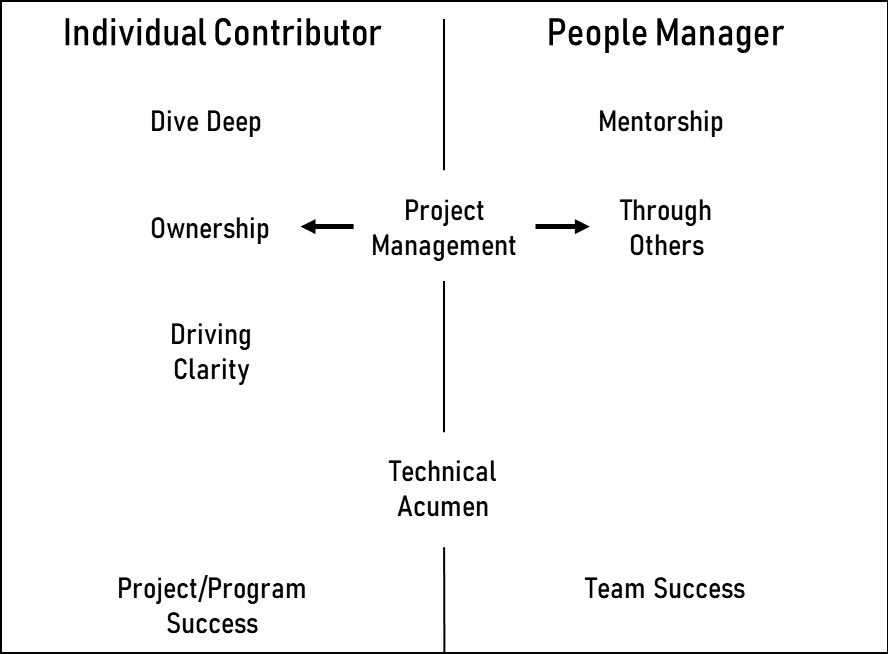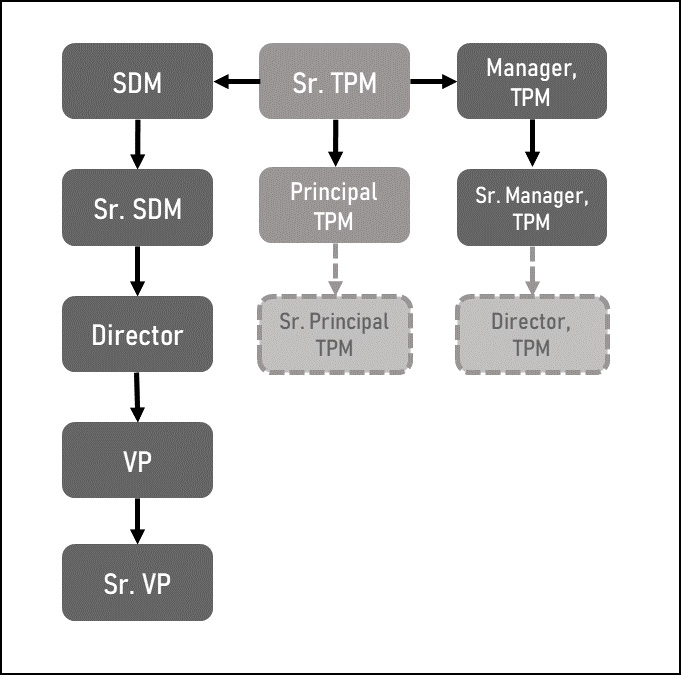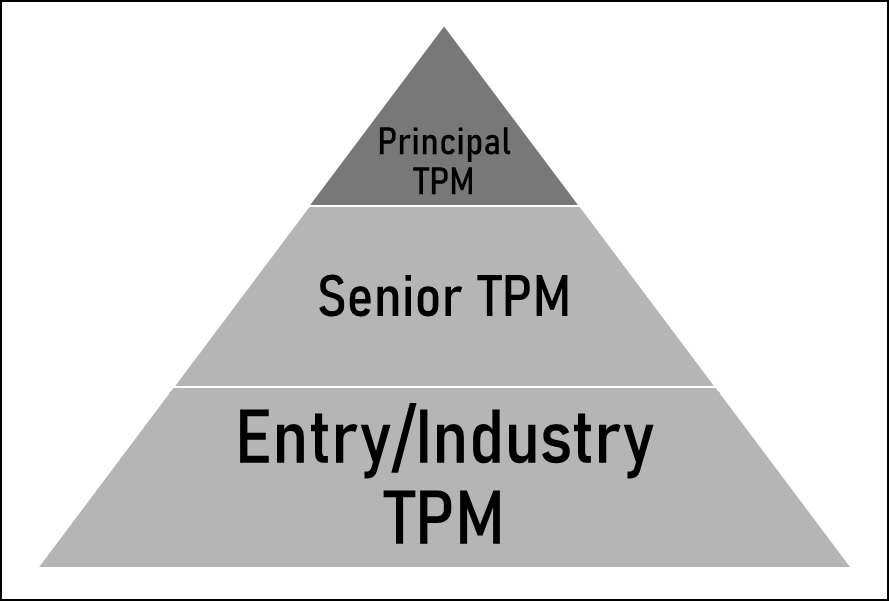9
Career Paths
In this chapter, we’ll look into the paths you may take to become a technical program manager (TPM), followed by a closer view of the different career paths that are available to a TPM. As the tech industry is large, the paths described here represent a generalized view of these career paths based on the interviews I have conducted, as well as the job descriptions available to me.
We’ll also get a close look at two professional TPM journeys that showcase the different paths you can take, which will reinforce that no two journeys are the same, nor are they ever straight paths.
We’ll explore the available career paths by doing the following:
- Examining the career paths of a TPM
- Exploring the individual contributor (IC) path
- Exploring the people manager path
Let’s dive right in!
Examining the career paths of a TPM
The career paths of a TPM are as varied as the paths to becoming a TPM in the first place. Each person has their own story and path they follow, and the timing from step to step is also just as variable as the number of TPMs. I’ve combined job postings, interview notes, and personal stories of TPMs at different stages of their career to get to the perspectives in this book. What the data only hints at, however, is where we will start. How do you become a TPM?
The path to becoming a TPM
The TPM role is highly technical in most instances across the tech industry, as well as in industries needing technical expertise. A key component to a successful start as a TPM is having a strong technical foundation. This is traditionally in the form of a technical degree, such as computer science (CS), information technology (IT), or informatics, with CS being the most traditional. Regardless of the name of the degree, the knowledge you carry from the degree and your experiences is what matters both in the interview process as well as the job itself. We’ll cover the technical competencies most often used on the job in Chapters 11, Code Development Expectations, and Chapter 12, System Design and Architectural Landscape.
I’ve seen TPMs start out their careers in various roles such as software development engineer (SDE or SE), development operations engineer (DevOps), and business intelligence engineer (BIE). On occasion, a TPM will start their career as a TPM out of college, though this is becoming a rare occurrence as many companies are removing entry-level roles for TPMs, opting instead for people switching to TPM after obtaining real-world experience. This experience helps grow your depth of knowledge by working directly on solving real problems. Depending on how far you go down the pre-TPM path, you’ll begin to work on your breadth of knowledge with system and architecture designs and possibly strategic product planning.
Some TPMs start out via an SDM role or other people management role, which usually stems from a software development role or another IC role. In these cases, they may see a product, project, program, or situation that suits them as they switch back to an IC TPM role. In other cases, they found that they prefer honing their IC skills instead of people management skills.
The paths of a TPM
Once you are a TPM, you’ll begin to progress in your career, strengthening your core competencies and stretching both the depth and breadth of your knowledge. Each company defines its own career paths, which can vary depending on size and available opportunities. Within the tech industry, there is a general trend toward two distinct paths you can take to further your career – the IC and the people manager. Both are equally valid and have their own unique traits that may fit your style and aspirations.
Figure 9.1 explores some of the traits that are both shared and distinct between an IC and a people manager:

Figure 9.1 – Traits of an IC versus a people manager
The IC role focuses heavily on the direct delivery of value and impact. The skills that you have grown to manage a project and program, navigate stakeholders, and dive deeply into issues are the main skills in your toolset. In general, your focus is on delivering the project or program that extends to ensuring your organization is on the right long-term path for project and program success.
Your focus as a people manager is on the success of your team. You mentor your direct reports and grow their skill sets by sharing the knowledge you gained as an IC. They grow as an IC and your entire team benefits. In this way, you are focused on the success of your team and by extension the programs and projects that they deliver.
There are some focal points of your role that are shared between IC and people management; however, the emphasis on that focal point may be different. For instance, as a TPM, project and program management are a central focus to you. As an IC, this comes out via individual ownership of a project or program. You thrive in owning and executing programs and projects and dive deeply into every aspect of the project. As a people manager, you work through others by guiding them so that they can be successful in delivering the program or project instead of delivering it by yourself.
Technical acumen is also shared across both of these different career paths, which makes sense given that they both share the same technical foundation. The depth and breadth of your technical knowledge may differ based on your chosen path as people managers will focus on a higher level of understanding of the systems their team owns or works in. As an SDM, this may also go deep into your own service but not necessarily the services surrounding you. As an IC, your technical acumen will depend on the needs of your projects and programs – you may dive deeply as an embedded TPM for a specific team, or you may have a broad understanding of the systems around you to better execute cross-functional programs. As your career develops and you go higher up, both the breadth and depth of your understanding will increase.
For people management, there are generally two paths available – a software development manager and a manager of other TPMs. Both paths are not always available depending on company philosophy, but these changes can also be accomplished between different companies and represent the two people manager paths most often taken by TPMs.
Figure 9.2 shows the career paths available for a TPM that chooses the people manager progression, and compares them to the IC path:

Figure 9.2 – TPM career paths
The center column represents the IC path, moving downwards toward the higher levels. The senior principal TPM position is listed here as it does exist in some companies, and I expect this trend to continue, but it isn’t mainstream as of now. The columns on either side represent the two people manager paths mentioned: SDM and TPM manager. As you can see, the typical first change from IC to people management is lateral – meaning you stay at the same level, just a different job family (for SDM) or classification (TPM manager).
The SDM path is where the potential to move upwards to senior VP is the most prevalent (though that doesn’t mean it’s easy, just that it’s a path well taken!). Of course, this can go beyond senior VP, but this is a good stopping point for illustrative purposes. Each level increases your team and influence (thus your impact).
The TPM manager path is often a shorter upward path as compared to the SDM route. Just like the senior principal TPM level, the director, TPM position is available in some organizations though not widespread. However, it is worth noting that once a people manager, moving from a TPM manager to SDM is a simpler move than from IC to people management.
Now that we’ve seen how IC and people management paths differ, let’s look at each path in more detail.
Exploring the IC path
The IC role is similar to that of other IC roles such as software developer. As it suggests, an IC will contribute directly to the success of the company through deliverables, whether that’s code for an SDE or delivering a project for a TPM. This role works as part of a team in the sense that they work with other ICs to deliver results. Unlike an SDE role though, a TPM will rarely work with other TPMs from their own team. Instead, when working with other TPMs it’s in a cross-organizational fashion.
Given that the IC role leans solely on the deliverables of the individual, the IC path tops off at the principal level in most companies. This is equivalent to a senior manager or director, depending on the company’s verticality. The reason for this largely comes down to the ability of a single person to have a large enough impact to warrant the level. Though TPMs are force multipliers, the people we work with are still within different organizations and their successes are not directly our own. The deliverables are also measured at the scope of a single program, and 0though this is large, it is not as large as the deliverables under a director or VP since they are measured by the entire work of their respective organization. This makes influencing without authority much harder at higher levels.
That’s not to say that a higher level isn’t achievable in some cases. For instance, Amazon recently merged the career path of the TPM and the software developer starting at the L8 level, now called the Senior Principal in Tech. This allows a TPM to achieve up to L10 as an IC which is a Distinguished Engineer in Tech (there is no L9 at Amazon). These roles show that at this level, your influence is geared towards the strategic goals of the company and the starting path is no longer relevant as you aren’t writing code or delivering on projects per se. Of the Big Five I interviewed, this level for the IC path was only seen at Amazon; however, this will likely be a trend we see moving forward that more companies to pick up.
Figure 9.3 denotes the career path of the IC TPM:

Figure 9.3 – IC career path
The IC career path is shown as a pyramid to denote not only the upward path but also the relative number that each of these positions holds within a company. This helps illustrate the complications of moving upward, as well as the diverging paths that lead to a smaller number of positions the further up you go.
The industry TPM position is largely considered a career position meaning that if you are happy at that level, you are not required to continue climbing. The senior position is also a career position, but it is also a crossroads for most TPMs as there is a split path at this point in your career. In the words of The Clash, “should I stay, or should I go?” You can choose the IC path and either stay a senior TPM, push upward to the principal, or you can pivot to the people manager path. As mentioned in Chapter 1, switching to people management is a popular shift at this level. This can be either through switching over to a software development management position or into a TPM manager role.
All of these paths are equally valid and which path is right for you depends on what you are looking for out of your career. Let’s look at the path of a current principal TPM to see why IC was ultimately the right choice for him.
Oscar Jaimes is a principal TPM at Amazon. His journey took him through both IC roles as well as people management roles. He received a degree in CS and worked as a software developer for six years. Toward the end of that time, he went back and got a master’s degree in business administration to help him move into project management, where he stayed for three years. From here, Oscar found opportunities where he would lead people and products, even being the chief technology officer for the Digital Business Unit at Latam Multinational. These positions were all strategic in nature and he helped build businesses and ideas from the ground up. He expanded his leadership up to thirty people as the director of innovation and business development – again, concentrating on growing a product from idea to launch. Though his path changed often, the main driving focus was the product and seeing it through. This is what led him to being a TPM at Amazon, launching multiple global products on his way to principal TPM in 2021.
Now that we have a good understanding of the IC path, let’s move on to the people manager career path and see what opportunities are available.
Exploring the people manager path
For TPMs, the people manager path goes in two directions for most companies in tech: SDM or TPM manager. Both of these paths switch focus from individual contributions to the company’s success and instead focus on your ability to bring success through others. By growing the careers of the people that report to you, their contributions grow, and the collective contributions of your team grow. The difference in the paths is the composition of your team as well as your mobility upward. Each company is different, but this is true for the Big Five companies that I interviewed for this book. As you will see in an example later, companies outside of the Big Five, or really any of the top tech companies, have their own progression route that may not differentiate between these two people manager paths.
The journey of a people manager can bounce between both SDM and TPM manager. Let’s take a look at the journey of a people manager that held both of these roles.
Faheem Khan is a senior manager TPM at Amazon. Throughout his career, he has been both an IC as well as a people manager in various forms. He started out ambitiously co-founding a start-up, Planetsoft, in India and found quick success with requests to build out enterprise solutions. He realized he needed to learn how enterprise software was created before committing to do so himself, so he got a job at a tech firm as a software tester.
When finding an issue, Faheem was driven to get the right people together to solve the problem. This tendency promoted him to test lead, where he moved to Seattle to work with Microsoft. He first shifted into people management as a Software Test Manager to build out the test framework used by Expedia. He enjoyed working with the users and stakeholders while building the framework. Faheem switched to the TPM job family to learn about business while still being close to technology at Expedia. He grew into a principal TPM, director, TPM, and then director of technology and managed cross-functional teams. He bounced back and forth between people management and program management. This back and forth led him to think about what he was best at and what he enjoyed doing. He decided that he was a leader of people and enjoyed project management in the technology space. Knowing what he wanted, he found a TPM management position at Amazon.
Faheem notes that whenever his career needed him to dive deep, he would take up an IC role so he could focus, learn, and hone new skills. Once those skills were present and he was ready to share and drive others, he would find a people manager role. This is an incredible insight and embodies both the breadth and depth of knowledge that is expected out of a TPM.
From both Oscar’s and Faheem’s journeys we’ve seen the hallmarks of what makes a great TPM. They exhibit a drive to see a project through to completion, a willingness to learn and help those around them grow, and a desire to dig deep. Even with these common traits, different paths were taken for each, and both held IC and manager roles, and each ended up preferring one path over the other in the end. Faheem’s insight that the type of role that was best suited for him depended on what he was looking to achieve rings true for all of us.
Summary
In this chapter, we examined the different paths that can lead to a TPM career, focusing on roles such as an SDE, DevOps, and even an SDM. We discussed the motivations for the switch to TPM as well as the paths that are often available once you are a TPM.
We saw that the IC role allows you to exercise your project and program skillsets and directly contribute to the success of your company. We followed the path of a principal TPM as he went from IC roles in product and program management, to people roles as a director and development manager.
We then explored the people manager role and how you focus on the growth of others by imparting your IC experience to achieve success for your team.
We also followed two different TPM professionals through their career journeys to see how their choices led them to different paths. Most importantly, we got a glimpse of why they made the decisions they made to help us better understand what career path may be best for us.
In Chapter 10, I’ll introduce you to the technical toolset that is fundamental for a TPM. I’ll discuss why a technical background is necessary, as well as which areas of your technical acumen are most utilized in the TPM role.
